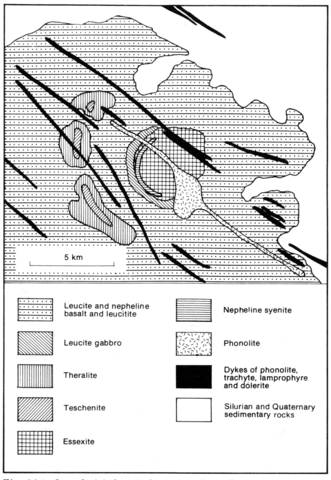stripes
Sapukai is an essexite plug cutting through olivine basalts and alkaline lavas, and is itself cut by dykes, mainly of phonolite. The alkaline lavas comprise principally leucitites and leucite and nepheline basanites, the chemistry of which is strongly potassic in character. The plug consists of outer and inner rings, the outer one comprising leucite tephrites and teschenites, and passing down into olivine basalts; biotite is plentiful and pseudoleucite also occurs. The inner plug, some 4 km in diameter, consists mainly of essexites containing phenocrysts of clinopyroxene, labradorite, a little olivine, nepheline, biotite and accessory apatite. In higher levels of the inner plug aegirine-nepheline microsyenite is found. Dykes of phonolite, trachyte with aegirine-augite and biotite, lamprophyres, described as akin to minettes but containing nepheline and some pseudoleucite, as well as kersantites, are abundant and extend to the northwest as far as Escobar. Some fenitization has been noted and attributed to phonolite dykes.
COMTE, D. and HASUI, Y. 1971. Geochronology of eastern Paraguay by the potassium-argon method. Revista Brasileira de Geociencias, 1: 33-43.
PALMIERI, J.H. and ARRIBAS, A. 1975. El complejo alcalino potasico de Sapukai (Paraguay Oriental). Congreso Ibero-Americano de Geologia Economica, Buenos Aires, 2: 267-300

